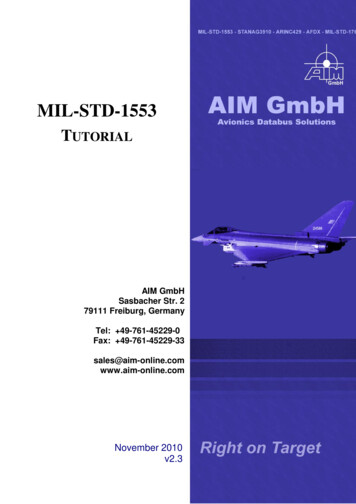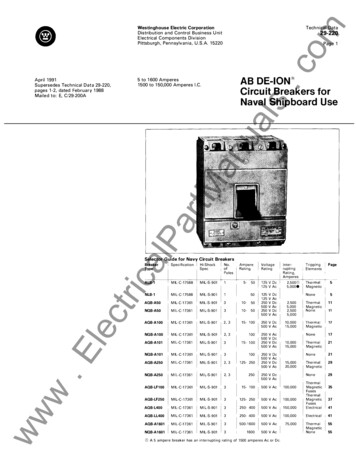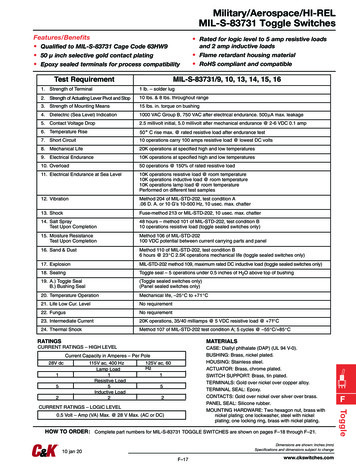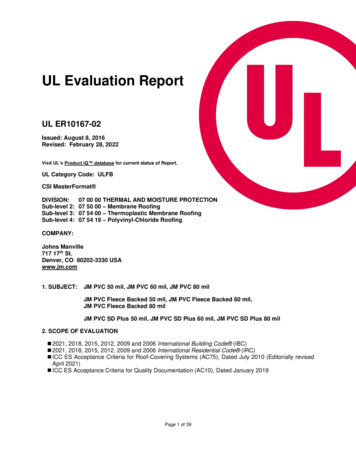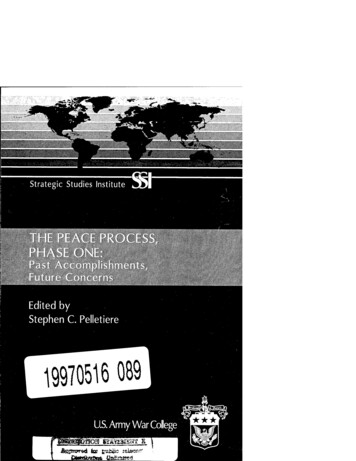
Transcription
STRATEGICSTUDIESINSTITUTEThe Strategic Studies Institute (SSI), co-located with the U.S. ArmyWar College, is the strategic level study agent for the Deputy Chiefof Staff for Operations and Plans, Department of the Army.The mission of SSI is to use independent analysis to conduct strategicstudies that develop policy recommendations on: Strategy, planning and policy for joint and combinedemployment of military forces;The nature of land warfare;Matters affecting the Army's future; The concepts, philosophy, and theory of strategy; and Other issues of importance to the leadership of the Army.Studies produced by civilian and assigned military analysts deal withtopics having strategic implications for the Army, the Department ofDefense, and the larger National Security community.In addition to its studies, SSI publishes special reports on topics ofspecial or immediate interest. These include but are not limited toedited proceedings of conferences and topically-orientatedroundtables, expanded trip reports, and quick reaction responses torequirements of the Office of the Secretary of the Army, the Officeof the Secretary of Defense, and the National Security Council.The Institute provided a valuable analytical capability within theArmy to address strategic and other issues in support of Armyparticipation in national security policy formulation.
Form ApprovedOMB No. 0704-0188REPORT DOCUMENTATION PAGEPublic reporting burden for this collection of information is estimated to average 1 hour per response, including the time for reviewing instructions, searching existing data sources,gathering and maintaining the data needed, and completing and reviewing the collection of information. Send comments regarding this burden estimate or any other aspect of thiscollection of information, including suggestions for reducing this burden, to Washington Headquarters Services, Directorate for information Operations and Reports, 1215 JeffersonDavis Highway, Suite 1204, Arlington, VA 22202-4302, and to the Office of Management and Budget, Paperwork Reduction Project (0704-0188), Washington, DC 20503.1. AGENCY USE ONLY (Leave blank)3. REPORT TYPE AND DATES COVERED2. REPORT DATEJanuary 3, 1997Final Report5. FUNDING NUMBERS4. TITLE AND SUBTITLEThe Peace Process, Phase One: Past Accomplishments, Future Concerns (U)6. AUTHOR(S)Stephen C. Pelletiere, Editor7. PERFORMING ORGANIZATION NAME(S) AND ADDRESS(ES)8. PERFORMING ORGANIZATIONREPORT NUMBERPublications and ProductionStrategic Studies InstituteU.S. Army War CollegeCarlisle, Pennsylvania 17013-5244 3LACN 9700/9. SPONSORING / MONITORING AGENCY NAME(S) AND ADDRESS(ES)10. SPONSORING / MONITORINGAGENCY REPORT NUMBER11. SUPPLEMENTARY NOTES12b. DISTRIBUTION CODE12a. DISTRIBUTION / AVAILABILITY STATEMENTApproved for public release; distribution unlimited13. ABSTRACT (Maximum 200 words)As a result of a conference on the peace process in the Middle East, co-hosted by the Strategic Studies Institute and NorthGeorgia College in March 1996, the authors discussed the developing crises in that area. They have analyzed three crucialareas of relations between Israel and its Arab neighbors-Jordan, Syria, and Lebanon. In these three essays, the authorsanalyze several key aspects of what can be considered the first phase of the Mideast Peace Process (the time from the 1991Madrid Conference to the 1996 Israeli election). They remind us that despite recent renewed progress on the IsraeliPalestinian agenda, the peace process has a long and difficult road ahead.15. NUMBER OF PAGES14. SUBJECT TERMSMiddle East; Arab-Israeli conflict; West Bank; Arab states; Gulf Cooperation Council; PLO;United States; United Nations; Golan Heights; Sunset Clause; Shias; Hizbollah; Saudi Arabia;Jordan; Israel; Lebanon9916. PRICE CODE17. SECURITY CLASSIFICATIONOF REPORT18. SECURITY CLASSIFICATIONOF THIS PAGE19. SECURITY CLASSIFICATIONOF ABSTRACT20. LIMITATION OF ABSTRACTUnclassifiedUnclassifiedUnclassifiedULNSN 7540-01-280-5500'*Standard Form 298 {Rev. 2-89)Prescribed by ANSI Std. Z39-1 8 298-102USAPPC V1.00
THE PEACE PROCESS, PHASE ONE:PAST ACCOMPLISHMENTS,FUTURE CONCERNSStephen C. PelletiereEditorJanuary 3,1997KSG QUALITY IFSFSnTil S
sjt sj» »ji Jjc »t» »i» *t»The views expressed in this report are those of the authors and donot necessarily reflect the official policy or position of the Departmentof the Army, the Department of Defense, Congressional ResearchService, or the U.S. Government. This report is cleared for publicrelease; distribution is unlimited. l« »I* ! ! »1* *fcrfi *J» »J* V *t* *t* *I*Comments pertaining to this report are invited and should beforwarded to: Director, Strategic Studies Institute, U.S. Army WarCollege, Carlisle Barracks, PA 17013-5244. Copies of this report maybeobtained from the Publications and Production Office by callingcommercial (717) 245-4133, DSN 242-4133, FAX (717) 245-3820, or viathe Internet at rummelr@carlisle-emh2.army.mil.H;******All 1995 and later Strategic Studies Institute (SSI) monographs areavailable on the Strategic Studies Institute Homepage for electronicdissemination. SSI's Homepage address is: http://carlisle-www.army.mil/usassi/.11
CONTENTSForewordvJordan and the Peace Process1Alfred B. PradosConsidering a U.S. Military Force on the Golan:Confronting the Hyperbole, Paranoia,Hysteria and Agendas21Stephen H. GotowickiHariri's Critique of Operation Grapes of Wrath:Implications for the Peace Process61Stephen C. PelletiereAbout the Authors93in
FIGURES1. Golan Heights Map and Cross Section242. Israeli-Syrian Equipment Balances363. Israeli-Syrian Combat Capable Aircraft374. Israeli-Syrian Military Strengths385. Israeli-Syrian Military Expenditures,1975-1993IV39
FOREWORDThis report grew out of a conference on the Mideast PeaceProcess that the Strategic Studies Institute held with NorthGeorgia College at the latter's Dahlonega, Georgia, campus inMarch 1996. At the time of the conference, Israel's PrimeMinister Itzak Rabin had already been assassinated, and hissuccessor, Shimon Peres, had called for new elections.Almost all of the participants at the conference feltconfident there would be a peace settlement before October1996. This was a confidence built on the widely held convictionthat, with so many powerful players calling for peace, it mustcome. Instead, the Israeli referendum on peace-as Peresdubbed the elections-turned out to be a victory for Israel'sLikud Party, whose leader, Benyamin Netanyahu, hadrepudiated many of the provisions of the agreements reachedto that time.It is not known what course the peace process will take oreven if it will continue. There is a danger, despite the bestefforts of the United States and the resumption of IsraeliPalestinian talks, that we will see a period marked by politicalstalemate, likely accompanied by increasing violence.The three essays which follow, however, take stock ofseveral key aspects of what can now be considered the firstphase of the Mideast Peace Process (i.e., that period from the1991 Madrid Conference to the 1996 Israeli election).In the first essay, Alfred B. Prados examines theJordanian-Israeli peace agreement, which vies with theIsraeli-Palestinian accords as the most positive developmentof the first phase. Prados outlines the history and terms of thislandmark agreement. His concluding observations about therisks King Hussein has taken are even more salient in today'scontext.Next, Lieutenant Colonel Stephen H. Gotowicki assessesin detail the issue of deploying U.S. troops on the GolanHeights. Recent Israeli and Syrian statements seem to havedoomed any near term Golan arrangement (and hence anIsraeli-Syrian settlement). However, should the peace processwith Syria suddenly resume, expectations of the United States
could be even greater, and a U.S. Army peacekeeping missionwould become the topic of intense debate in Washington.Finally, Dr. Stephen C. Pelletiere's study of OperationGRAPES OF WRATH looks at possible Israeli and Syrianmotives underlying the violent exchanges in April 1996 insouthern Lebanon. His analysis does not augur well for whatlies ahead on the peace front. U.S. policymakers must movequickly to exploit-or at least to try to control-developments inthe Syria-Lebanon tangle of relations.These three essays, then, illuminate different piecesJordan, the Golan, Lebanon-of the large tapestry of a peaceprocess whose final dimensions are not clear, or, for thatmatter, certain of completion. What is clear are the high stakesfor U.S. diplomacy and national security interests attendanton the outcome.RICHARD H. WITHERSPOONColonel, U.S. ArmyDirector, Strategic Studies Institutevi
JORDAN AND THE PEACE PROCESSAlfred B. PradosSince the establishment of the state of Israel in 1948,Jordan has been the linchpin in long-standing efforts toresolve the Arab-Israeli conflict. Among Arab states, Jordanhas the longest border with Israel and hosts the largestnumber of displaced Palestinians. Until 1967, Jordangoverned the principal portion of pre-1948 Palestine thatremained in Arab hands after the 1948 war, namely theWest Bank territory including eastern Jerusalem. Jordanlost the West Bank to Israel in 1967, and King Husseinformally severed Jordan's administrative ties to the WestBank in 1988; however, in practice, the future of Jordan andthe fate of the Palestinian community have remained closelylinked.This linkage between Jordan and the Palestiniancommunity has seriously circumscribed King Hussein'sfreedom of maneuver in negotiating with Israel. The kinghas always felt a special responsibility toward hisPalestinian subjects and toward the Islamic holy places inJerusalem, some of which he continued to administer evenafter the Israeli occupation of the West Bank. With morethan half of his population of Palestinian origin, the kinghas had to measure any concession he might offer Israelagainst the weight of public opinion in Jordan. To a largedegree, Jordanian steps toward negotiation with Israel havehad to move in tandem with the Palestinian leadership.The problem for King Hussein has been compounded bythe vulnerabilities of Jordan's geographic positionsandwiched between Israel and the neighboring Arab statesof Syria, Iraq, and Saudi Arabia. Syria and Iraq, governedby left-leaning socialist regimes sometimes hostile toJordan, have opposed negotiations with Israel in the past,at least on terms the latter would be likely to accept. BothArab states have mounted direct military threats to Jordan
on previous occasions. Saudi Arabia, a source of muchneeded financial support to Jordan in the past, has notopposed negotiations in principle but does not countenanceseparate peace arrangements and is sensitive to anysettlement that might forfeit Muslim interests inJerusalem. Hussein, on his part, is well aware that he issurrounded by militarily stronger neighbors and that hiseconomy heavily depends on foreign aid. Consequently, hehas had to avoid actions that would unduly provoke Israelon the one hand, and policies that appeared to stray too farfrom the Arab consensus on the other.With these constraints, it is remarkable that Jordan hasemerged as the second Arab country to sign a peace treatywith Israel. Even more remarkable is King Hussein'sdetermination to build a "warm peace" with Israel incontrast to the chilly relations that have prevailed betweenIsrael and Egypt since the conclusion of their peace treatyin 1979. To do this, the king will have to harness a somewhatreluctant Jordanian public, withstand likely criticism (andpossibly more active opposition) from Syria and severalother regional states, and perhaps deal with a future Israeligovernment less inclined to accommodate Jordanian andother Arab concerns. King Hussein's ability to achieve thisgoal may be the ultimate test of his skill in governing a smallbut sometimes fractious kingdom and maintaining itssecurity in an unfamiliar and changing environment.A brief summary of Jordanian involvement in theArab-Israeli peacemaking process may shed some light onthe development of Jordanian-Israeli relations in the yearsahead. The story of Jordan's role encompasses severalphases, which will be covered below: the early-and largelyabortive-history of peace efforts between Israel and Jordan;a 2-year negotiating process under a U.S.-Russiansponsored process that began in 1991; the rapid conclusionof bilateral agreements in 1993 and 1994; and the processof establishing normal relations between Jordan and Israel,arguably the most intricate and demanding task facingJordan's leaders.
Early Peace Efforts.Direct, open Jordanian negotiations with Israel are ofrecent vintage, beginning in 1991 with Jordan's acceptanceof the negotiating framework proposed by then U.S.President George Bush. Jordanian involvement in peacemoves, however, is as old as the Arab-Israeli conflict itself.Even before the initial Arab-Israeli war in 1948, Jordan'sfounder, King Abdullah, had contacts with Israeli emissary(later prime minister) Golda Meir in an unsuccessful effortto head off the impending conflict. According to unofficialreports, King Hussein (King Abdullah's grandson, whoacceded to the throne in May 1953) had private contactswith Israeli leaders long before public negotiations began in1991. For the first 38 years of Hussein's reign, domestic andregional considerations precluded a direct negotiatingforum between Jordan and Israel. Nonetheless, this periodwitnessed some significant indirect steps along the road toformal negotiations between the two countries.Israel's territorial gains in the 1967 Arab-Israeli war,including its occupation of the West Bank territory whichJordan had governed since 1948, created a new set ofconditions that have formed the backdrop for subsequentdevelopments in Arab-Israeli affairs. United Nations (UN)Security Council Resolution 242 of November 22, 1967,which stipulated return of occupied territories in exchangefor peace and mutual recognition, provided a framework forsubsequent Arab-Israeli negotiations. Jordan, like Egypt,accepted the resolution in the context of a comprehensivepeace but dismissed any proposals for a separate peace withIsrael as "neither possible nor sensible."2 Until 1993, atwo-fold principle formed the cornerstone of Jordan'sposition on Arab-Israeli negotiations-acceptance of a peaceagreement based on the return of Arab territories occupiedby Israel, but only as part of a comprehensive settlementaccepted by all parties including the Palestinians.Jordan was prepared to press the envelope of theseconstraints in an effort to find negotiating opportunitieswith Israel, sometimes at the risk of domestic and regional
Opposition. Between September 1970 and July 1971, theJordan Armed Forces suppressed armed Palestinianguerrillas who for 3 years had launched cross-border raidsagainst Israel and defied Jordanian governmentalauthority. In taking this step, King Hussein reestablisheda quiet border with Israel, but his actions were widelydecried in the Arab world and the Palestinian community.In 1972, he presented a proposal for a "Unified ArabKingdom," which would consist of two loosely federatedstates, the Jordanian East Bank and the Palestinian WestBank, under the central authority of the Hashemitemonarchy. This proposal, which largely would have restoredthe situation that existed before 1967, was not acceptableto Israel and was condemned by Syria, Iraq, Egypt, Libya,and the Palestine Liberation Organization (PLO). In 1982the king praised U.S. President Ronald Reagan's plan forArab-Israeli negotiations as "positive" and "constructive,"and in February 1985 he reached tentative agreement withPLO Chairman Yasir Arafat on a joint negotiating strategywith Israel. Syria and several radical Palestinianorganizations condemned the Hussein-Arafat agreement asa U.S.-Israeli inspired plot, and it collapsed a year later.With rare exceptions, however, Hussein has not beenprepared to abandon the Arab consensus in pursuingnegotiations with Israel. In November 1994, at an Arabsummit conference held in Rabat, Morocco, the kingreluctantly endorsed the decision of the conferees torecognize the PLO as the sole representative of thePalestinian people, thereby weakening Jordan's ability tonegotiate Palestinian and West Bank issues.Demonstrating once again his opposition to separate peacearrangements, King Hussein joined most other Arab leadersin condemning the 1978 Camp David Accords, which led toa bilateral peace between Egypt and Israel. Camp Davidalso envisioned a role for Jordan and Egypt in a proposal forPalestinian autonomy, which Hussein and other Arabsviewed as deficient in meeting Palestinian aspirations. In1988, acceding to "the PLO's desire and the general Araborientation" for Palestinian self-determination, KingHussein announced the disengagement of Jordan from the
West Bank. Finally, Jordan's growing rapprochement withIraq in the 1980s, though mainly related to economicconsiderations and mutual concerns over Iran, had theeffect of increasing Jordanian tensions with Israel andassociating King Hussein indirectly with the stridentanti-Israeli posture adopted by Iraqi President SaddamHussein on the eve of Iraq's invasion of Kuwait in August1990.The Gulf and Its Aftershocks.Jordan's refusal to join the allied coalition after the Iraqiinvasion of Kuwait and its sympathetic posture toward Iraqresulted in one of the most serious crises in the country'shistory. Though popular among Jordanians (especiallythose of Palestinian origin) and supported by public opinionin many parts of the Middle East, King Hussein's perceivedtilt toward Iraq alienated important allies in the Arab worldand the West. Saudi Arabia and other Gulf statesterminated subsidies to Jordan (running at approximately 450 to 500 million) and expelled over 300,000 Jordanianexpatriate workers, who consequently were no longer ableto send back a portion of their earnings to Jordan, creatingyet another burden on the Jordanian economy. Tourism,which provided approximately 500 million in 1989,virtually disappeared. Politically, Jordan was shunned notonly by the Gulf states but by several other Arab membersof the allied coalition, notably Egypt. The United States,angered by Jordan's stand, suspended a total of 105 millionin economic and military assistance to it during fiscal years1991 and 1992 although these funds were graduallyreleased in 1993.With the defeat of Iraq, Jordan had two principal optionsin seeking to restore relationships injured by the Gulf crisis:a clear-cut reversal of its former support for Iraq or a revivalof previous Arab-Israeli peacemaking endeavors. The twoapproaches were not necessarily mutually exclusive, and, infact, King Hussein has pursued both of them, albeit atdifferent paces, since 1991. An immediate Jordanian moveto sever relations with Iraq, however, was economically
unfeasible at the time in view of the many commercial linksthat remained between the two countries; among otherthings, Jordan continued to depend on Iraq to meet its oilneeds of 60,000-75,000 barrels per day since Saudi Arabiahad cut off oil supply to Jordan. The other option,cooperation in peacemaking with Israel, offered noimmediate prospects of an improvement in Jordanianrelations with Gulf states, but it would be welcomed in theUnited States, which recognized that Jordanianparticipation was essential in seeking resolution of severalcore Arab-Israeli issues, notably the Palestinian problem.Bilateral Talks and Agreements.In the summer of 1991, a major Arab-Israeli peacemaking initiative designed by then U.S. President GeorgeBush and Secretary of State James A. Baker providedJordan with an avenue of escape from its diplomatic andeconomic isolation. Even before President Bush and thenSoviet President Mikhail Gorbachev issued a jointinvitation to an international peace conference, KingHussein informally signalled Jordan's willingness toattend 7 Even more important than this early acceptancewas King Hussein's offer to facilitate the negotiating processby providing an "umbrella" for a Palestinian delegation inthe form of a joint Jordanian-Palestinian team (the onlyformat acceptable to Israel at that time for inclusion ofPalestinian representatives). This formula of a jointJordanian-Palestinian delegation was maintained duringtwo years of bilateral negotiations that followed the openingconference held in Madrid on October 30,1991. As time wenton however, the Jordanian and Palestinian components otthe delegation began to conduct their meetings with Israelisin a separate format. Meanwhile, secret contacts betweenIsraeli and Palestinian negotiators outside the frameworkof the U.S.-Russian sponsored bilateral talks led to thelandmark Declaration of Principles signed by then IsraeliPrime Minister Yitzhak Rabin and PLO Chairman Arafatin Washington on September 13,1993.6
The historic Israeli-Palestinian agreement caught KingHussein by surprise and confronted him with an altered setof circumstances. At first, he expressed irritation thatJordan had not been consulted, particularly in view ofJordan's efforts to coordinate its peacemaking activitieswith the Palestinians. He seems to have realized quickly,however, that this unexpected development provided himwith unprecedented opportunities: first, his peacemakingstrategy need be encumbered no longer with the burden ofsupervising a joint Jordanian-Palestinian effort; andsecond, the unprecedented recognition of the state of Israelby Arafat gave Jordan essential political cover to pursue itsown moves with Israel. In addition, the king seems to haverealized that further progress in peacemaking might helpunlock doors to international economic assistance. Althoughthe United States had released previously suspended aidfunds to Jordan by mid-1993, the country faced a debt ofover 7 billion (almost twice Jordan's gross domesticproduct) with no outlook for continued aid at a significantlevel. These considerations imparted fresh momentum toJordanian-Israeli talks which subsequently resulted inthree milestone agreements.The Common Agenda. The first Jordanian-Israeliagreement was already in the making by the time Arafatand the late Israeli Prime Minister Yitzhak Rabin met onthe White House lawn. In actuality, by late 1992 Jordanianand Israeli negotiators had drafted an agenda and formedfive working groups to deal with principal bilateral issues.On September 14, the day after the Israelis and Palestinianssigned their declaration, the heads of the Jordanian andIsraeli delegations with much less fanfare signed theirso-called "common agenda," which listed issues to beaddressed by both sides with the goal of achieving a just,lasting, and comprehensive peace among the Arab states,the Palestinians, and Israel as per the Madrid invitation.Shortly afterward, in the the highest level official contactbetween the two countries so far, Jordan's Crown PrinceHassan met with then Israeli Foreign Minister ShimonPeres in Washington on October 1 and agreed with their
U.S. hosts on the formation of a tripartite commission todiscuss economic cooperation.The Non-Belligerency Declaration. Once again, progresson the Israeli-Palestinian track coupled with prospects ofeconomic benefits to Jordan gave added impetus toIsraeli-Jordanian negotiations. On May 4,1994, Israeli andPalestinian representatives reached agreement on theterms of a Palestinian self-rule regime to begin in Gaza andJericho. During the following month, U.S. President Clintonpromised King Hussein that he would work to obtain debtrelief for Jordan, presumably in recognition of Jordan'speacemaking role. Concurrently with these developments,there was an increase in the frequency and level ofJordanian-Israeli contacts. On July 9, King Hussein statedin a speech to the Jordanian parliament that he was readyto meet with Israeli Prime Minister Rabin if such a meetingwould advance the interests of Jordan. Six days later,President Clinton announced that the Jordanian monarchand the Israeli prime minister would meet in Washington,stating that this historic meeting is another step forwardtoward achievement of a comprehensive and lasting peacein the Middle East.On July 25, in the first public contact between theJordanian monarch and a top Israeli official, King Husseinand Prime Minister Rabin signed a declaration at the WhiteHouse. The terms of the declaration expanded on those ofthe 1993 Common Agenda and included the followinghighlights: termination of the state of belligerency betweenJordan and Israel; negotiations to end economic boycotts;establishment of communications, electric, and air links;establishment of border crossings; Israeli agreement torespect Jordan's historic role in administering Islamic holyplaces in Jerusalem; and further negotiations toward afull-fledged peace treaty. The two leaders addressed a jointsession of the U.S. Congress the same day. Congressresponded by enacting legislation to forgive a portion ofJordan's debt to the United States (see below), butaccompanying congressional statements suggested that afinal peace treaty (as well as Jordan's compliance with8
economic sanctions against Iraq) would be a factor in furtherdebt forgiveness.The Peace Treaty. This time the two countries movedmore rapidly to consummate their movement toward peace.On October 17, Jordanian Prime Minister Abd al-Salamal-Majali and Israeli Prime Minister Yitzhak Rabininitialed a peace treaty, which the two officials subsequentlysigned at a ceremony held on the Jordanian-Israeli borderon October 26. President Clinton and 5,000 notables fromvarious countries witnessed the occasion. The 120-memberIsraeli Knesset (parliament) ratified the treaty by a vote of105-3 with six abstentions on October 25. On November 6,the 80-member Jordanian lower house of parliamentendorsed the treaty by a vote of 56-23 with one absentee.The royally appointed Senate endorsed it by a vote of 33-0with one abstention and six absentees, and ratificationbecame final with the king's signature on November 10.The treaty, which consists of 30 articles and fiveannexes, stipulates that peace is established between thetwo countries "effective from the exchange of the instruments of ratification of this Treaty" (Article 1). The treatyprovides for recognition of each other's sovereignty, borders,and political independence (Article 2); demarcation ofborders within nine months of the treaty's signature (Article3); refraining from threats or use of force against each other(Article 4); exchange of ambassadors within one month oftreaty ratification (Article 5); water sharing arrangements(Article 6); freedom of access to religious shrines and respectfor Jordan's historic role regarding Muslim holy places inJerusalem (Article 9); repeal of discriminatory legislation(Articles 11 and 26); and a number of provisions coveringcooperation in economic, administrative, scientific, andcultural fields.One interesting aspect of the treaty concerned thedemarcation of borders. Aside from the West Bank, whichdid not figure prominently in the treaty negotiations,territorial issues between Jordan and Israel were minor,consisting of several small border areas that Jordan claimedIsrael had occupied through various encroachments9
between 1948 and 1967, amounting to approximately 340square kilometers. Under Annex I of the treaty, Israelagreed to return these areas to Jordan; however, the partiesagreed on an arrangement whereby Jordan will allow Israelilandowners and farmers continued use of two smallenclaves within this territory for a 25-year period. Thislease-back arrangement, which is renewable after 25 years,has been singled out for special criticism by opponents of thepeace treaty as an unnecessary territorial concession toIsrael.Prospects for Durable Peace.What are the prospects for a viable and durable peacebetween Jordan and Israel? In an effort to answer thisquestion, it would be useful to examine four more specificones. First, what has Jordan gained from the peace treatywith Israel? Second, how strong is internal support inJordan for normalization with Israel and other recent shiftsin official Jordanian policy? Third, what degree of supportcan Jordan expect from its other neighbors in the MiddleEast for its role in the peacemaking process? Fourth, whateffect will future arrangements to resolve the Palestinianquestion have on Jordan's role in peacemaking with Israel?Gains to Jordan. The fruits of peace for Jordan aredifficult to assess. Some limited benefits will accrue toJordan through recent agreement with Israel in the form ofcivil air access, preferential trade arrangements, andrevenues from tourism. Although Israeli tourists havebegun to visit Jordan on short trips, so far they have notproved to be heavy spenders. The removal of trade barrierscould be a double-edged sword; Jordanians, like otherArabs, are uneasy over the possibility that their economycould be dominated by that of their stronger neighbor.Israeli willingness to accept tariff provisions weighted inJordan's favor may reflect Israel's understanding ofJordanian concerns and its realization that Jordan is a vitallink in Israeli economic access to the farther reaches of theMiddle East.10
Beyond the potential economic benefits of open borders,Jordanian leaders hoped that peace with Israel would leadto an influx of foreign aid, particularly from the UnitedStates. They have recognized reluctantly, however, that, inan era of budgetary constraints, there is little likelihood thatJordan will realize a peace dividend on the scale thataccrued to Israel and Egypt after their peace treaty in 1979.A few comparative figures illustrate the lowered expectations to which Jordan must adjust. For the first fiscal yearfollowing their peace treaty, Israel and Egypt received 2.4billion and 1.7 billion, respectively, in U.S. economic andmilitary aid, and by 1985 their respective annual aid levelshad risen to 3.0 and 2
GRAPES OF WRATH looks at possible Israeli and Syrian motives underlying the violent exchanges in April 1996 in southern Lebanon. His analysis does not augur well for what lies ahead on the peace front. U.S. policymakers must move quickly to exploit-or at least to try to control-developments in the Syria-Lebanon tangle of relations.
